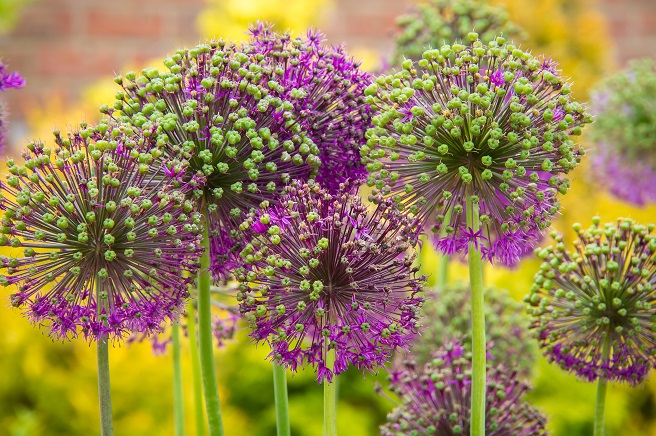Perennials are living plants that continue to bloom and thrive year after year.
Because they do not require replanting annually, they save you time, effort and money.
Typically, perennials have a shorter blooming season, ranging from two to three weeks depending on the type.
By carefully planning your garden, you can arrange for your perennial flowers to peak at various times throughout the season for a continually changing landscape with a fresh, new environment every few weeks.
You can also group early, mid-season and late-blooming perennials together to provide a continual backsplash of color.
Before selecting the right perennials for your garden, consider the following questions:
- Where do you plan to locate your perennials?
- Is the area exposed to direct or indirect sunlight? Is it shaded?
- How much time do you have to devote to gardening tasks?
- How long is the growing season in your region? What is the climate like?
- What are the unique characteristics of certain popular perennials?
1. Planting, Maintenance and Selection
Whether you are the type of gardener who likes to spend a lot of time or only a little in the great outdoors, you’re sure to find just what you need with the wide range of available types and varieties of perennials.
Before you get started, take some time to think about your layout.
You’ll want to select specimens that match your climate, soil and growing season.
Also consider light, as some perennials will not bloom in shady locations.
Because perennials are planted and left in the same spot for many years, location is important.
Familiarize yourself with the types of plants that are best suited to your area.
You may even want to observe the plants in your neighborhood, taking note of ones that appear to be growing well.
2. Planting Tips
Taking time to properly prepare your soil is one of the best things you can do to ensure your perennials continue to thrive over the years.
Check for proper soil drainage and test pH levels to ensure that the growing environment is conducive to the plants.
Most perennials are planted in the spring, though some bulbs and spring-blooming perennials can be set out late in the summer or early fall.
Avid gardeners and enthusiasts may consider starting perennials from seeds.
This method is quite cost effective but requires a bit more effort.
Follow the planting directions on the back of the seed packet for best results.
- It is recommended that you prep your soil in the fall for best results
- Add fertilizer and rake soil smooth in the spring to prepare for new plants
- If soil has poor drainage, consider planting items in raised beds
- Gently untangle roots and place in a hole slightly larger than the root ball
- Plants should be positioned at the same height they were at in the container
- Be sure to allow plenty of space between plants to encourage better growth
- Plant late summer or fall blooming perennials in the spring
- Plant spring flowering perennials in late summer or early fall
3. Maintenance and Care
Put frequent and thorough watering at the top of your maintenance checklist.
An effective watering strategy hydrates plants and promotes good root development.
You may want to add mulch to your garden for its water-retention capabilities.
Mulch also provides protection during the harsh winter months and creates an attractive and orderly appearance in flowerbeds.
After blooms have withered, remove dead flower heads and cut stems down to the ground.
Fertilize perennials in March, then repeat every six weeks to carry the plants through the summer.
Apply another treatment to late-blooming plants at the end of summer.
Always water plants after fertilizer has been applied to prevent burn.
When perennials reach their growth threshold, use a sharp implement to divide the mature plant directly down the middle.
Place the split sections in their new beds; and replace the soil around the “mother” plant.
Rooting or transplant hormone can be added to minimize shock.
- Plant perennials where light, wind and soil conditions are suited to them (consult information provided when you buy plants or seeds)
- When watering, moisten the entire plant bed, but not so heavily that the soil becomes soggy
- If possible, wet only the soil around the plant, not the leaves and bloom, to avoid making the plant susceptible to disease
- Apply mulch after several frosts have occurred to ensure soil temperature remains low
- Don’t apply mulch too early as the warmth can cause new growth, which may freeze and damage the plant
- Stake tall perennials to prevent stem damage using stakes that measure 6 to 12 inches shorter than the plant
- Tie the plant by making a double loop, with one loop around the plant and the other around the stake
4. Selecting Perennials
When it comes to choosing the right perennials, many factors come into play.
You need to consider everything from the look and color of a plant to its peak blooming time and ideal soil conditions.
Also, make sure that the plant is compatible with your region’s climate.
Location plays an equally important role.
Check the height, size and growing preferences of each type, and locate plants to their best advantage.
For example, gladiolas provide a tall, colorful backdrop to shorter plants, and hostas may be perfect for ringing a tree in a shady side yard.
Most perennials are sold when they are in bloom, allowing you to select the colors you want.
Choose plants that are compact and dark green before flowering.
Avoid plants with thin, pale, yellow stems and leaves or visible signs of mold or mildew.
| Characteristics | Plant |
| Bloom once per season | · Astilbe · Baptisia · Eupatorium (snakeroot) |
| Cool temperatures | · Aconitum (monkshood) · Delphinium (larkspur) · Lupine |
| Drought resistant | · Asclepias (butterfly flower) · Gaura (wand flower) · Russian sage |
| Fine foliage | · Hosta · Japanese painted fern · Tiarella, “Jeepers Creepers” |
| Long bloomers | · Rudbeckia (black-eyed Susan) · Salvia (meadow sage) · Shasta daisy |
| Long-lived perennials | · Hosta · Iris · Peony |
| Short-lived perennials | · Columbine · Foxglove · Hollyhock |
Live Plants
Usually grown in 1- or 5-gallon containers, although some plants are sold in smaller containers.
These plants are already matured and are ready to be placed into your garden for immediate aesthetic enhancement.
Seeds
Less expensive than buying live plants but require more time and maintenance.
For best results, follow the planting instructions included on the back of the seed packet.
Bulbs
Some perennials are sold as bulbs, such as daylilies.
Follow the instructions included with your bulbs to ensure proper planting and maintenance.
Many bulbs are planted in the fall and bloom the following spring and summer.

